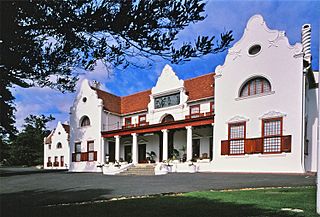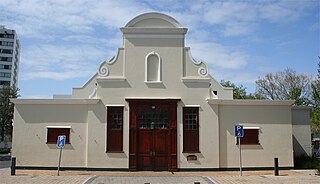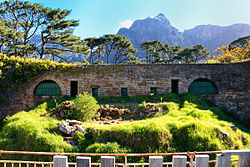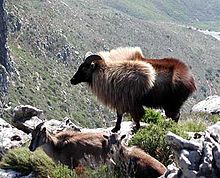
Tahrs or tehrs are large artiodactyl ungulates related to goats and sheep. There are three species, all native to Asia. Previously thought to be closely related to each other and placed in a single genus, Hemitragus, genetic studies have since proven that they are not so closely related and they are now considered as members of three separate monotypic genera: Hemitragus is now reserved for the Himalayan tahr, Nilgiritragus for the Nilgiri tahr, and Arabitragus for the Arabian tahr.

Table Mountain is a flat-topped mountain forming a prominent landmark overlooking the city of Cape Town in South Africa. It is a significant tourist attraction, with many visitors using the cableway or hiking to the top. Table Mountain National Park is the most visited national park in South Africa, attracting 4.2 million people every year for various activities. The mountain has 8,200 plant species, of which around 80% are fynbos, meaning fine bush. It forms part of the Table Mountain National Park, and part of the lands formerly ranged by Khoe-speaking clans, such as the !Uriǁʼaes. It is home to a large array of mostly endemic fauna and flora. Its top elevates about 1.000 m above the surrounding city, making the popular hike upwards on a large variety of different, often steep and rocky pathways a serious mountain tour which requires fitness, preparation and hiking equipment.

Devil's Peak is part of the mountainous backdrop to Cape Town, South Africa. When looking at Table Mountain from the city centre, or when looking towards the city across Table Bay, the skyline from left to right consists of Devil's Peak, the flat summit of Table Mountain, the peak of Lion's Head, and Signal Hill.

The University of Cape Town (UCT) is a public research university in Cape Town, South Africa. Established in 1829 as the South African College, it was granted full university status in 1918, making it the oldest university in South Africa and the oldest university in Sub-Saharan Africa in continuous operation.

Groote Schuur Hospital is a large government-funded teaching hospital situated on the slopes of Devil's Peak in the city of Cape Town, South Africa. It was founded in 1938 and is famous for being the institution where the first human-to-human heart transplant took place, conducted by University of Cape Town-educated surgeon Christiaan Barnard on the patient Louis Washkansky.

A menagerie is a collection of captive animals, frequently exotic, kept for display; or the place where such a collection is kept, a precursor to the modern zoo or zoological garden.

Rondebosch is one of the Southern Suburbs of Cape Town, South Africa. It is primarily a residential suburb, with shopping and business districts as well as the main campus of the University of Cape Town.

Sir Herbert Baker was an English architect remembered as the dominant force in South African architecture for two decades, and a major designer of some of New Delhi's most notable government structures. He was born and died at Owletts in Cobham, Kent.
The South African College Schools is a public English medium primary and high education institution situated in Newlands – part of the Southern Suburbs region of Cape Town in the Western Cape province of South Africa. Founded in 1829, it is the oldest continuously run school in South Africa.

Groote Schuur is an estate in Cape Town, South Africa. In 1657, the estate was owned by the Dutch East India Company which used it partly as a granary. Later, the farm and farmhouse was sold into private hands. Groote Schuur was later acquired by William De Smidt, and remained in the family's possession until it was sold by Abraham De Smidt, Surveyor General of the Cape Colony, in 1878, and was bought by Hester Anna van der Byl of the prominent Van Der Byl / Coetsee family. In 1891 Cecil Rhodes leased it from her. He later bought it from her in 1893 for £60 000, and had it converted and refurbished by the architect Sir Herbert Baker. The Cape Dutch building, located in Rondebosch, on the slopes of Devil's Peak, the outlying shoulder of Table Mountain, was originally part of the Dutch East India Company's granary constructed in the seventeenth century.

Table Mountain National Park, previously known as the Cape Peninsula National Park, is a national park in Cape Town, South Africa, proclaimed on 29 May 1998, for the purpose of protecting the natural environment of the Table Mountain Chain, and in particular the rare fynbos vegetation. The park is managed by South African National Parks. The property is included as part of the UNESCO Cape Floral Region World Heritage Site.

The Rhodes Memorial is a large monument in the style of an ancient Greek temple on Devil's Peak in Cape Town, South Africa, situated close to Table Mountain. It is a memorial to the English-born South African politician Cecil John Rhodes, was designed by architect Herbert Baker and finished in 1912.

Cape Dutch architecture is an architectural style found mostly in the Western Cape of South Africa, but modern examples of the style have also been exported as far afield as Western Australia and New Zealand, typically on wine estates. The style was prominent in the early days of the Cape Colony, and the name derives from the initial settlers of the Cape being primarily Dutch. The style has roots in medieval Netherlands, Germany, France and Indonesia.

The Southern Suburbs are a group of Anglophone suburbs in Cape Town, Western Cape, South Africa.

Observatory is a suburb in Cape Town, South Africa, colloquially known as Obs. Bordered by Mowbray to the south and Salt River to the northwest, the area is best known as a student neighbourhood associated with the nearby University of Cape Town and Groote Schuur Hospital. It takes its name from the South African Astronomical Observatory headquarters, built in 1829 by the Royal Observatory.

The 2009Table Mountain fire was a large fire in and around the Table Mountain National Park in Cape Town, South Africa. It broke out at approximately 20:30 on 17 March 2009 in the vicinity of Rhodes Memorial and initial fears were that the fire would spread to UCT's Upper Campus. The Table Mountain National Park quickly deployed firefighting personnel on the mountain, but the fire spread due to the strong winds. At around 23:20 on Tuesday evening, the fire started moving up Devil's Peak and by 00:00 was at the tip and making its way around the mountain to the suburbs of Tamboerskloof, Oranjezicht, Vredehoek and Gardens on the north side. The flames were engulfing the mountain and the huge amounts of smoke made it hard for rescue and fire-fighting helicopters making their way to the fire. By 00:30, people from the aforementioned areas were told to evacuate due to the strong winds pushing the fire around the mountain. By this time, Fire & Rescue Services had deployed 29 fire engines and 90 firefighters who were assisted by 45 firefighters from the South African National Parks and volunteers of Disaster Management
The following is a timeline of the history of Cape Town in the Western Cape province of South Africa.

Tygerberg Zoo was a 24-hectare (59-acre) zoo near Stellenbosch, South Africa, which was the only zoo in the Western Cape province and the closest to Cape Town. Established in 1979, it was privately run, operated for 33 years, and closed in 2012. It was "once a major tourist attraction and a hot spot for school educational outings" according to Cape Times coverage of its closure. Featured animals included chimpanzees and tigers, lions, and cheetahs. The zoo had 160 bird species and 63 reptile species, and "specialised in breeding rare and endangered animals."

The following outline is provided as an overview of and topical guide to Cape Town:

State House, formerly called Government House, is a former Government House in Bulawayo, Zimbabwe. It was used by the British South Africa Company during their rule in Rhodesia. It was built by Cecil Rhodes in 1897 as his personal residence. It is now used as the official Bulawayo residence for the President of Zimbabwe.



















